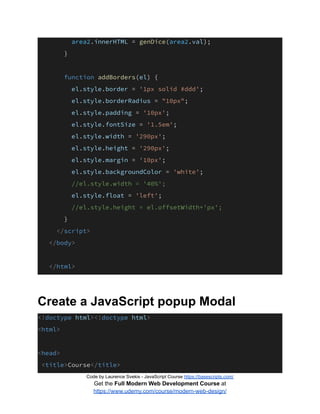The jQuery val() method can be used to return or set the value attribute of the selected element. You can use this method for the elements inside the form tag to get or assign a value to them. jQuery val() method. Syntax. There are three syntax of this method which are given below:-
The val() method is an inbuilt method in jQuery that is used to return or set the value of attributes for the selected elements. This method applies to the HTML form elements. Syntax: There are three ways to use this method which are given below: $(selector).val()
Use .text() instead of .val() when you want to get or set the text of an element. Use .each() function when you want to get the value of every element in a matched set. Check the type of the element before using .val() function. To summarize, the jQuery .val() function is a versatile tool to work with form elements.
.val() vs .attr() Use the .val() Method to Set Value of the textarea; Use the .attr() Method to Set Value for the textarea; In JavaScript, we instantiate an instance of the HTML element, id, or class via the querySelector() method. But for the examples. In this tutorial, we will use jQuery(#id) Again, other conventions exist to set values for the text area, like adding proper attributes in
However, jQuery.val() standardises the interface for collecting the selected value in select boxes; where as in standard HTML you have to resort to using .options[this.selectedIndex].value. Share. Improve this answer. Follow answered Sep 6, 2011 at 15:Matt Matt. 75.3k 26 26
The val() method is an inbuilt method in jQuery that is used to return or set the value of attributes for the selected elements. This method applies to the HTML form elements. Syntax: There are three ways to use this method which are given below: $(selector).val() Use .text() instead of .val() when you want to get or set the text of an element. Use .each() function when you want to get the value of every element in a matched set. Check the type of the element before using .val() function.
To summarize, the jQuery .val() function is a versatile tool to work with form elements. .val() vs .attr() Use the .val() Method to Set Value of the textarea; Use the .attr() Method to Set Value for the textarea; In JavaScript, we instantiate an instance of the HTML element, id, or class via the querySelector() method. But for the examples. In this tutorial, we will use jQuery(#id) Again, other conventions exist to set values for the text area, like adding proper attributes in However, jQuery.val() standardises the interface for collecting the selected value in select boxes; where as in standard HTML you have to resort to using .options[this.selectedIndex].value. Share.
Improve this answer. Follow answered Sep 6, 2011 at 15:Matt Matt. 75.3k 26 26
Learn how to use the .val() method to get or set the value of form elements such as input, select and textarea. See examples, syntax, description and related methods.
Explanation: In this example at the beginning, the value of the input field is changed with the JavaScript API and then after 2 seconds the value of the input field is shown in an alert prompt using the jQuery val() method which returns the value of the input field changed by JavaScript API and also change the input field using jQuery val() method.
Learn how to use the val () method to return or set the value attribute of HTML form elements with jQuery. See examples, syntax, parameters and a try it yourself section.
.val() works on input elements (or any element with a value attribute?) and .text() will not work on input elementsval() gets the value of the input element -- regardless of typetext() gets the innerText (not HTML) of all the matched elements:.text() The result is a string that contains the combined text contents of all matched elements. This method works on both HTML and XML documents.
javascript - Difference between val () and text () - Stack Overflow
Learn how to use the .val() method to get or set the value of form elements such as input, select and textarea. See examples, syntax, description and related methods. Explanation: In this example at the beginning, the value of the input field is changed with the JavaScript API and then after 2 seconds the value of the input field is shown in an alert prompt using the jQuery val() method which returns the value of the input field changed by JavaScript API and also change the input field using jQuery val() method. Learn how to use the val () method to return or set the value attribute of HTML form elements with jQuery. See examples, syntax, parameters and a try it yourself section.
.val() works on input elements (or any element with a value attribute?) and .text() will not work on input elementsval() gets the value of the input element -- regardless of typetext() gets the innerText (not HTML) of all the matched elements:.text() The result is a string that contains the combined text contents of all matched elements. This method works on both HTML and XML documents.
jQuery val() sets or returns the value attribute of the selected elements. Syntax: When it is used to get value. $(selector).val() When it is used to set value. $(selector).val(value) Value: Value is a compulsory parameter, used to specify the value of the attribute. When it is used to set value by calling function.



